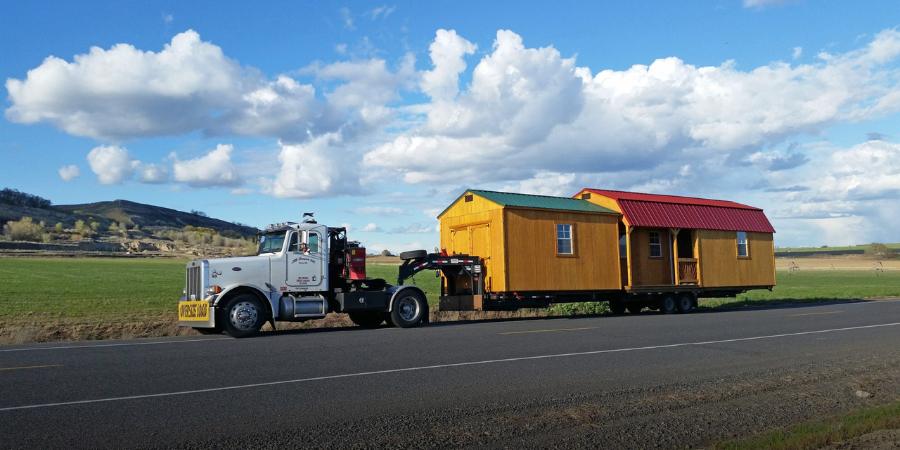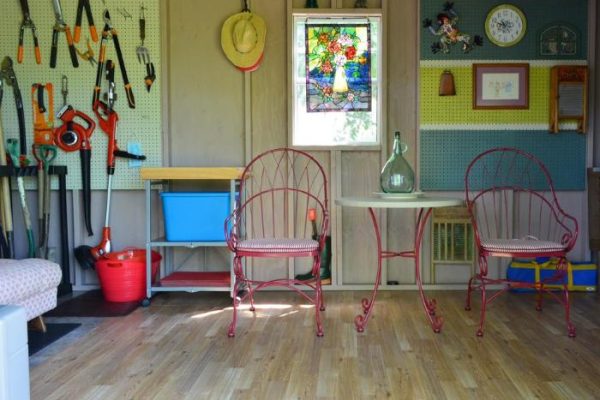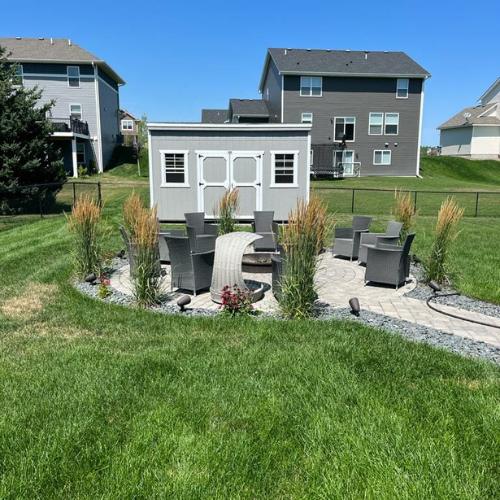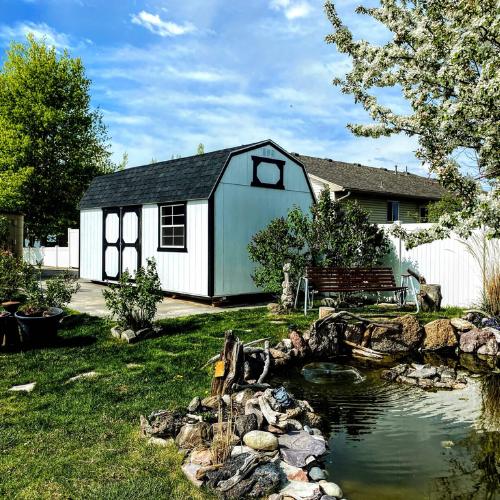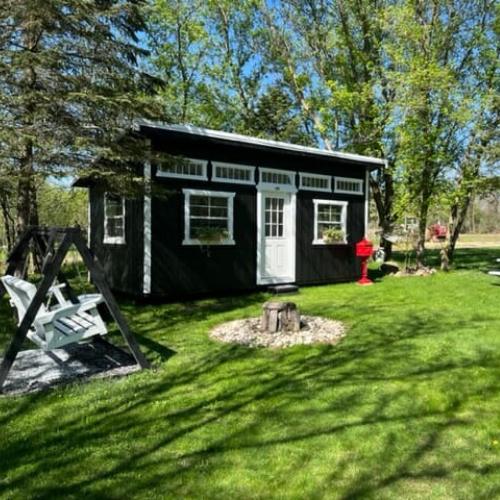How to Choose a Shed: Essential Tips
Key Highlights
- Assess your unique storage requirements to determine the right shed size
- Consider the different types of sheds available, from tool sheds to workshops
- Evaluate your storage needs and the specific items you plan to store in the shed
- Take into account the size considerations and available space in your outdoor area
- Follow a step-by-step guide to select the perfect shed, including determining your budget, choosing the right location, and considering local building codes and restrictions
Introduction
Introducing the world of sheds! Whether it’s for storing your garden tools or creating a cozy workspace, finding the right shed can enhance your outdoor experience. With a wide range of sizes and materials available, it’s essential to consider your storage needs and available space. From plastic to metal sheds, each option has its benefits. Let’s dive into the details to help you make an informed decision for your outdoor storage solution.
Why Invest in a Backyard Storage Shed?
Maximize your outdoor space’s potential with a storage shed. From decluttering tools to creating a workspace, sheds offer versatility and organization. Invest in a shed for added functionality and improved property value.
The Role of a Shed in Your Outdoor Space
Sheds play a crucial role in maximizing your outdoor space. They offer practical solutions for storing tools, equipment, and seasonal items, helping to declutter your home. Additionally, sheds can provide a dedicated workspace for hobbies or DIY projects, creating a functional and organized environment within your property. By choosing the right shed size and design that suits your needs, you can enhance the usability and aesthetics of your outdoor area, making it a valuable extension of your home.
Different Types of Outdoor Sheds: From Tool Sheds to Workshops
When choosing the right backyard shed, consider different types catering to various needs, from basic a storage shed for equipment, a garden shed for garden supplies to fully equipped studio shed as your workshop. Storage sheds and garden sheds are ideal for storing garden tools and bulky equipment, while workshops offer hobby space for DIY projects and your own office space.
Understanding the purpose of your shed will guide you towards selecting the most suitable type. Assess your requirements to determine the functionality needed, whether it’s for basic storage or a dedicated workspace.
Evaluating Your Outdoor Shed Requirements
Assessing your storage needs is crucial when choosing the right shed size. Consider what items you’ll store, such as power tools, outdoor furniture, or seasonal items. Factor in available space and future needs to make an informed decision.
Whether you opt for a compact shed for basic storage or a larger one for extra space, ensure it fits well in your outdoor area while meeting functionality needs. A shed that stands the test of time saves you hassle in the long run.
Assessing Your Storage Needs: What Will You Store?
Assess your storage needs by considering what items you plan to store in the backyard shed. Determine if it’s for gardening tools, gardening equipment, outdoor equipment, or other belongings. Understanding your storage requirements will help you choose the right shed size and layout for optimal organization.
How Home Owners are Using Sheds for Purposes Other than Storage
Many homeowners are now utilizing sheds for more than just storage. Sheds have evolved into versatile spaces serving various purposes beyond storing tools and equipment. Some homeowners convert sheds into cozy backyard retreats, home offices, hobby workshops, or even personalized gyms. These multifunctional sheds cater to individual preferences and provide a private sanctuary away from the main house. It’s fascinating how sheds have become essential extensions of living spaces, offering endless possibilities for creativity and relaxation.
Size Considerations: Finding the Perfect Fit for Your Space
When determining the how much storage space you will need, consider your storage needs and the available space. Assess what items you plan to store, such as power tools or outdoor furniture, to ensure enough room. Think about future needs and ensure the shed can accommodate seasonal items like lawn mowers or snowblowers. Take into account access requirements, like double doors for easy entry. By balancing functionality and space, you can choose the perfect shed size that suits your needs and fits seamlessly into your outdoor space.
Here is a great example of using a shed as your own home office, making great use of the space and incorporating your own taste and style.
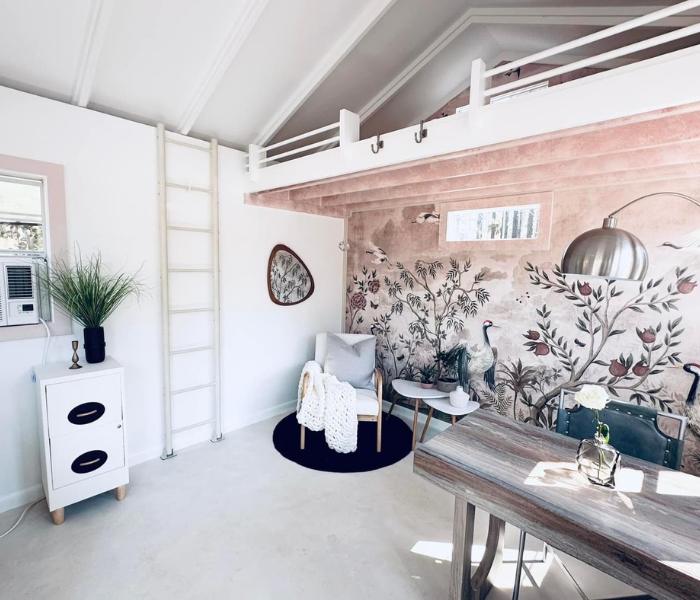
The Beginner’s Guide to Shed Selection
Equipment and Resources Needed to Get Started
Before embarking on selecting the right shed, gather essential equipment and resources necessary to kickstart your project. A measuring tape, level, and gloves are handy tools for accurate measurements and safe handling. Quality building materials and a reliable source of power tools will streamline the construction process. It’s also beneficial to have a dedicated workspace with ample lighting for assembling and customization tasks. Prepare with these basics to ensure a smooth and successful shed selection journey.
Step 1: Determine Your Budget and Space Constraints
Before embarking on your shed selection journey, it’s vital to first identify your budget limitations and the space available. Setting a clear budget ensures you stay within your financial comfort zone, while understanding your space constraints helps in choosing the right shed size that will allow for the right amount of floor space for a seamless fit. By evaluating these aspects from the outset, you can make an informed decision and streamline the process of finding the perfect shed to meet your needs. This initial step sets the foundation for a successful shed selection process.
Step 2: Choose the Right Location for Your Shed
When selecting the perfect spot for your shed, consider easy access and visual appeal. Ensure it complements your landscape and doesn’t obstruct any pathways. Think about natural light and ventilation for your shed’s functionality. Check local regulations for building permits and property lines. Remember to place your shed on a level surface like concrete pavers for stability.
Step 3: Selecting a Style That Complements Your Home
When choosing a shed style, consider how it will complement your home. Opt for a design that blends seamlessly with your property’s aesthetics. Match the shed’s colour and architecture with your house to create a cohesive look. Whether you prefer a traditional or modern style, ensuring that it harmonizes with your home’s exterior will enhance your overall outdoor space. Selecting a shed that complements your home adds not just practical storage but visual appeal as well.
Step 4: Consider Local Building Codes and Restrictions
Before starting your shed project, it’s vital to explore local building codes and restrictions. These regulations dictate aspects like shed size, placement, and materials. Compliance ensures a smooth approval process and avoids costly modifications later on. Check with your municipality for specific guidelines on setbacks, height limitations, and necessary permits. By considering these factors from the outset, you can save time and reduce the hassle of dealing with potential issues down the road.
Refer to our Guide to Backyard Sheds and City of Calgary By-Laws for more info.
Step 5: Select the Type of Material You Want
For selecting the material for your shed, consider factors like durability, maintenance, and aesthetics. Common options include wood, metal, and resin. Wood offers a classic look but may require more maintenance. Metal sheds are durable and low-maintenance but can be prone to rust. Resin sheds are easy to clean and maintain. Evaluate your preferences, budget, and the climate in your area to make the best choice. Choose a material that suits your needs and complements your outdoor space.
Step 6: Consider Functionality
You will want to determine the shed doors configuration and quantity of doors depending on the items you will be storing. If you have bulky equipment you may want to consider double doors. If you have a vehicle you would like to store, then a garage door would be suitable.
Meet The Shed Lineup
Portable Buildings Alberta offers high-quality, customizable portable buildings and modular structures for various industries. We provide efficient, turnkey solutions with seamless design, transportation, and installation services.
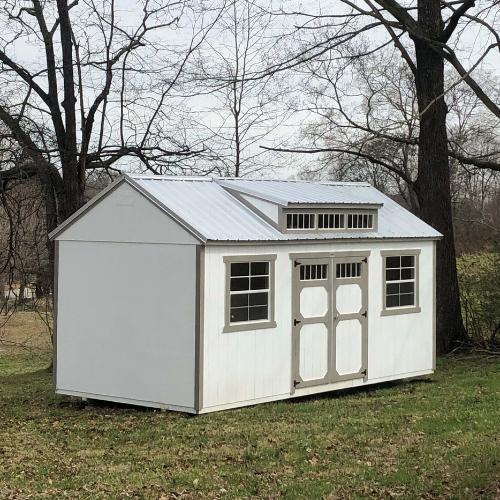
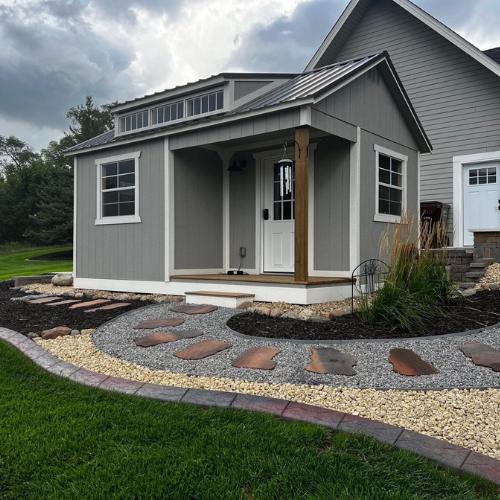
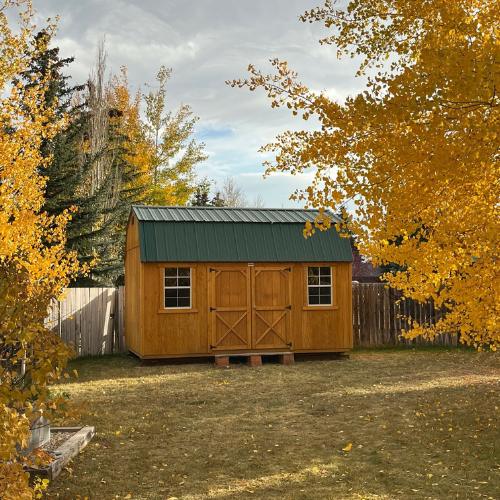

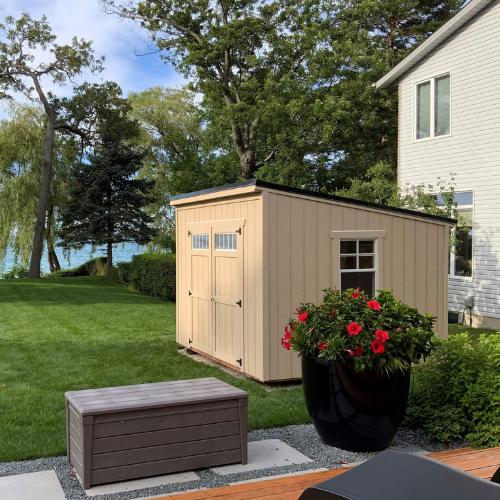
Incorporating Your Shed into Your Landscape
Incorporating your shed into your landscape is essential for creating a visually appealing and harmonious outdoor space. By carefully considering the placement and design of your shed, you can seamlessly integrate it into your garden or yard. Here are a few tips to help you achieve this:
- Consider the landscaping around your shed. Use plants, shrubs, and flowers to soften the edges and create a natural transition between the shed and the surrounding garden.
- Choose a shed design and colour that complements your existing outdoor aesthetic. Consider matching the shed with the colours of your house or other structures in your yard.
- Add decorative elements such as window boxes, trellises, or climbing vines to enhance the visual appeal of your shed.
- Create pathways or walkways that lead to your shed, making it easily accessible and inviting.
- Use outdoor lighting to illuminate your shed and highlight its features, especially at night.
By incorporating your shed into your landscape, you can turn it into a beautiful focal point and enhance the overall visual appeal of your outdoor space.
Planning Your Shed’s Location for Accessibility and Visual Appeal
When planning the location of your shed, it’s important to consider both accessibility and visual appeal. Here are some factors to keep in mind:
Accessibility: Choose a location that is easily accessible from your house and other areas of your yard. Consider the proximity to paths, driveways, and entrances. You want to minimize the distance and obstacles you have to navigate when retrieving items from your shed.
Views: Take advantage of any scenic views or focal points in your yard. Position your shed in a way that allows you to enjoy these views while also considering privacy if necessary.
Convenience: Think about how you will use your shed and what items you will store inside. If you plan to store gardening tools, place the shed near your garden for easy access. If you will be using the shed as a workshop, consider proximity to electricity and water sources.
Legal requirements: Check with your local municipality or homeowner’s association for any regulations or permits required for shed placement. Some areas may have restrictions on the distance from property lines or the size of the shed.
By carefully planning the location of your shed, you can ensure that it is easily accessible, visually appealing, and enhances the overall functionality of your outdoor space.
Landscaping Ideas to Enhance Your Shed’s Surroundings
Enhancing the surroundings of your shed with thoughtful landscaping can elevate the overall aesthetic appeal of your outdoor space. Here are some landscaping ideas to consider:
Plantings: Use plants, flowers, and shrubs to create a natural and vibrant backdrop for your shed. Consider the colours and textures of the plants to complement the design and colour of the shed.
Pathways: Create a pathway leading to your shed using materials such as gravel, pavers, or stepping stones. This not only adds visual interest but also enhances accessibility.
Complementary design: Choose landscaping elements that complement the style and design of your shed. For example, if your shed has a rustic charm, incorporate elements like wooden benches or trellises into the surrounding area.
Add focal points: Consider adding focal points near your shed, such as a small garden statue, a birdhouse, or a decorative planter. These elements can draw the eye and create visual interest.
Consider the maintenance: Choose plants and landscaping elements that are low-maintenance and appropriate for your climate. This will ensure that your shed’s surroundings remain beautiful without requiring excessive upkeep.
By incorporating these landscaping ideas, you can create a cohesive and visually appealing outdoor space that complements your shed and enhances the overall aesthetic of your property.
Shed Installation Tips
Proper installation is crucial for the longevity and stability of your storage shed. Here are some shed installation tips to keep in mind:
Foundation preparation: Before installing your shed, ensure that the foundation is properly prepared. This may involve leveling the ground, removing any vegetation, and laying a solid foundation such as concrete pavers or a poured concrete slab.
Site preparation: Clear the area where you plan to install the shed, removing any debris or obstacles. Make sure the site is level and provides proper drainage to prevent water damage.
Level the ground: Use a shovel and a level to even out the ground. Remove any high spots and fill in any low spots to achieve a level surface.
Here are some instructions for a DIY base to set your shed on.
Our most popular and best base recommendation is a gravel pad that is made out of crushed stone. This provides a stable base for your shed to rest on, and is very effective at draining water away from the bottom of your shed, as well as being affordable.
You will need the pad to be one foot bigger then the shed all around. For example a 10’x12′ shed will need a pad that measures 12×14′. The process starts by finding the right location then digging out the ground to approximately a 4″- 6″ depth. Place commercial quality landscape fabric on the exposed area and then add your crushed stone on the fabric and compact. Add material until the area is completely level. You may use this type of base for any size project for our portable sheds.
Maintenance and Care for Your Shed
Proper maintenance and care are essential for the longevity and functionality of your shed. Here are some tips to keep your shed in optimal condition:
Regular maintenance: Inspect your shed regularly for any signs of damage, wear, or pests. Address any issues promptly to prevent further damage.
Weatherproofing: Apply weatherproofing treatments such as sealants or paints to protect your shed from the elements. This will help prevent rot, fading, and water damage.
Pest prevention: Take steps to prevent pests such as insects or rodents from infesting your shed. Seal any gaps or cracks, keep the area around the shed clean, and consider using pest repellents if necessary.
Cleaning: Regularly clean the interior and exterior of your shed to remove dirt, debris, and potential breeding grounds for pests. Use mild detergents or cleaning solutions suitable for the shed’s material.
By following these maintenance and care tips, you can ensure that your shed remains in excellent condition, providing reliable storage and protection for your belongings.
Routine Checks and Upkeep to Prolong Your Shed’s Life
To prolong the life of your shed and ensure its continued functionality, it’s important to perform routine checks and upkeep. Here are some tasks to include in your shed maintenance routine:
Seasonal items: Rotate and organize seasonal items to prevent unnecessary wear and tear. Store items that are not in use in a safe and organized manner.
Regular inspections: Perform regular inspections of your shed, checking for any signs of damage or wear. Look for leaks, cracks, or pest activity. Address any issues promptly.
Cleaning: Regularly clean both the interior and exterior of your shed to remove dirt, debris, and potential sources of damage. This includes sweeping, dusting, and treating for pests if necessary.
Weatherproofing: Monitor the condition of the weatherproofing treatments on your shed and reapply as needed. This will ensure continued protection against the elements.
Upkeep: Perform any necessary repairs or maintenance tasks, such as replacing damaged parts, tightening screws, or repainting. This will help your shed withstand the test of time.
By incorporating these routine checks and upkeep tasks into your shed maintenance plan, you can extend the life of your shed and ensure its continued functionality.
Frequently Asked Questions
What is the most cost-effective size for a shed?
The most cost-effective shed size depends on your budget and storage needs. Consider how much extra storage space you require and how you plan to utilize the shed. Opting for a slightly larger shed can be more cost-effective in the long run, as it allows for future storage needs without the need for additional purchases.
How can I maximize space in my small shed?
To maximize space in a small shed, use shelving units to create vertical storage. Utilize hooks and racks to organize tools and equipment. Additionally, consider using space-saving storage solutions such as hanging baskets or magnetic strips to make the most of every inch.
Can I install a shed by myself, or should I hire professionals?
Whether to install a shed yourself or hire professionals depends on your skill level, time commitment, and the complexity of the installation. Smaller sheds can often be installed by DIY enthusiasts, but larger sheds may require professional help. Check local regulations to determine if a building permit is necessary.
How do I choose the right material for my climate?
When choosing the right material for your shed in a specific climate, consider factors such as durability, weather resistance, and maintenance requirements. Opt for materials that can withstand the climate’s unique challenges, such as extreme temperatures, high humidity, or heavy snowfall.

